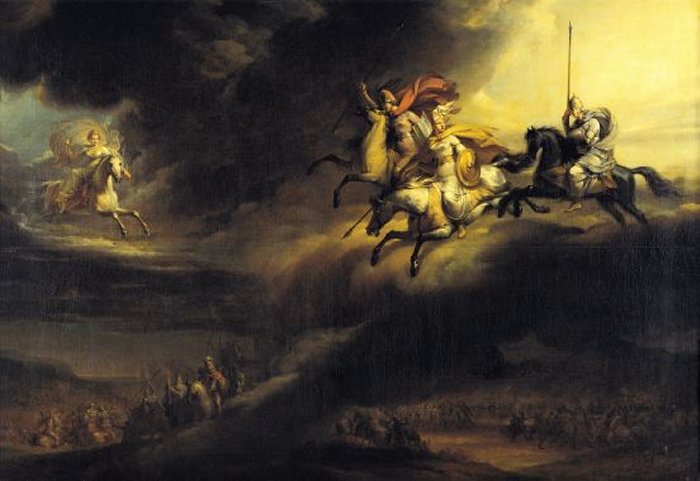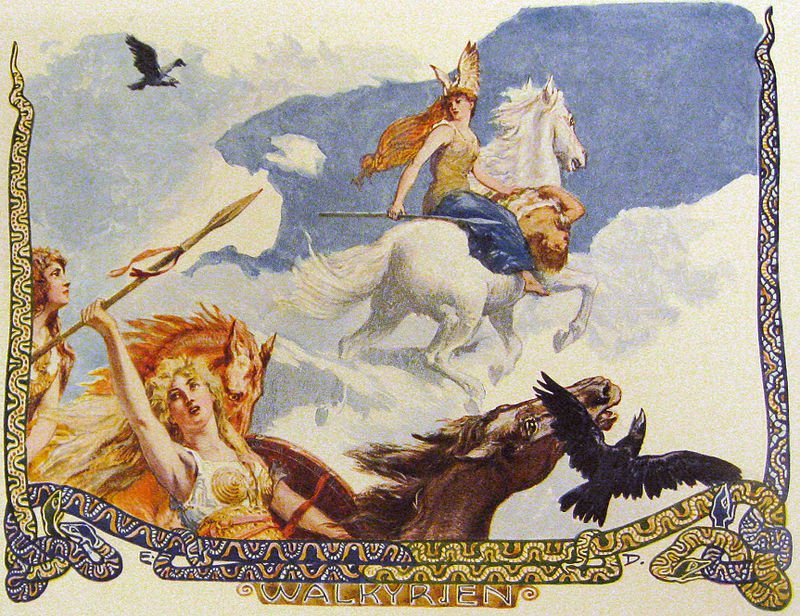Mysterious And Powerful Valkyries In Norse Mythology: The Choosers Of The Slain
A. Sutherland - AncientPages.com - In Norse mythology, the Valkyries were the choosers of the slain. The Valkyries were females riding on horses armed with helmets and spears. They would decide who would die in battle and drift over the battleground to find their prey.
Valkyrior rida till striden (1818) by Johan Gustaf Sandberg (Translation: Valkyries riding to the battle). Credit: Public Domain
Selecting among half of those who die in battle, the Valkyries bring their chosen to the afterlife hall of the slain, Valhalla, ruled over by the great god Odin.
The other half of the fallen warriors were taken to the goddess Freyja's afterlife field Folkvangr (Fólkvangr).
The goddess Freya had the first pick of the fallen Vikings.
The Valkyries Were Not Allowed To Be Seen By Humans
According to Norse mythology, the Valkyries were female virgins, and when a battle took place, there were usually between six and thirteen Valkyries at one time.
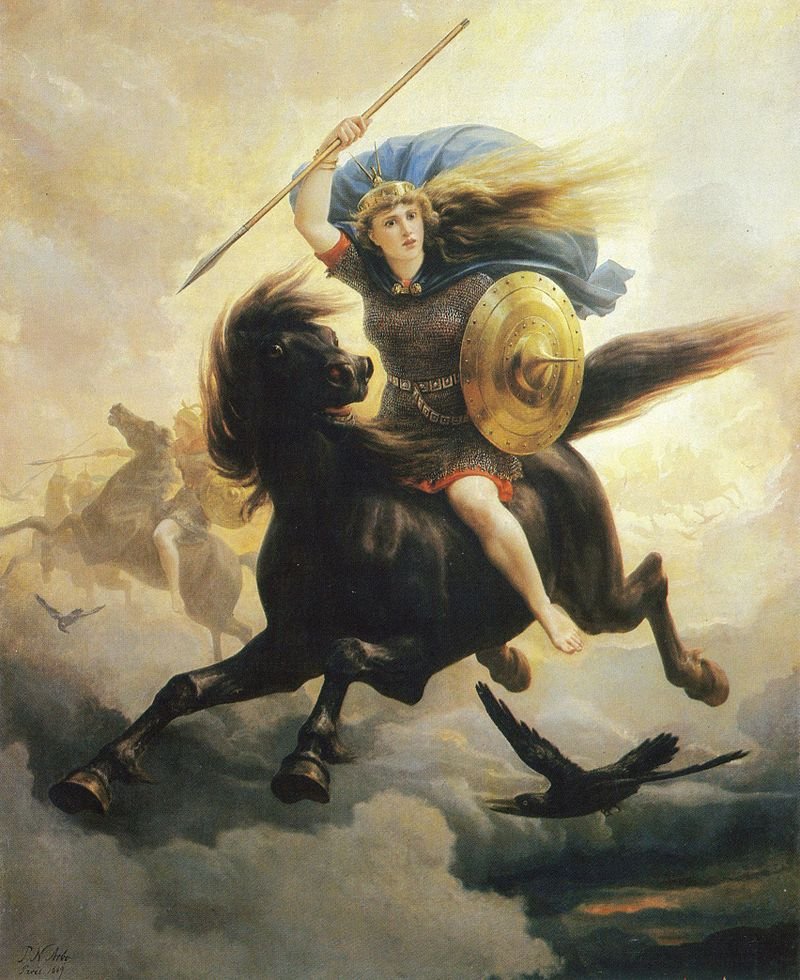 Valkyrie (1869) by Peter Nicolai Arbo. Credit: Public Domain
Valkyrie (1869) by Peter Nicolai Arbo. Credit: Public Domain
Some of the Valkyries had higher ranks and were treated with great respect. Some received unique gifts, and Odin allowed a few maidens to become swans. It allowed them to venture throughout Midgard and mingle with the humans. But if they were seen by the humans, not in their swan form, they would forever turn mortal and could never return to Valhalla.
These Valkyries were also attributed to ravens, as well as swans. These creatures were significant in battles within Old Norse literature, often choosing who would win and who would lose. They also took lovers, suffered punishments from Odin, and even were credited with changing the course of history throughout Viking mythology.
The Valkyries in ancient texts
The name originates from the Old Norse Valkyrja, "chooser of the slain."
Walkyrien (c. 1905) by Emil Doepler. Credit: Public Domain
Valkyries are attested in the Poetic Edda, a book of poems compiled in the 13th century from earlier traditional sources; the Prose Edda and Heimskringla (by Snorri Sturluson) Njáls saga, a Saga of Icelanders, all written in the 13th century. They appear throughout the poetry of skalds, in a 14th-century charm, and various runic inscriptions.
Archaeological discoveries reveal the importance of the Valkyries
Several Viking Age stylized silver amulets depicting women with long gowns, their hair pulled back, sometimes bearing drinking horns, have been discovered throughout Scandinavia. According to archaeologists and historians, the amulets were placed in Viking graves because they were thought to have protective powers.
The Tjängvide image stone from the island of Gotland, Sweden, features a rider on an eight-legged horse, which may be Odin's eight-legged horse Sleipnir, being greeted by a female, which may be a Valkyrie at Valhalla. The 11th-century runestone U 1163 features a carving of a female bearing a horn that has been interpreted as the Valkyrie Sigrdrífa handing the hero Sigurd (also depicted on the stone) a drinking horn.
Valkyries in other ancient cultures
Various theories have been proposed regarding the origin and development of the valkyries.
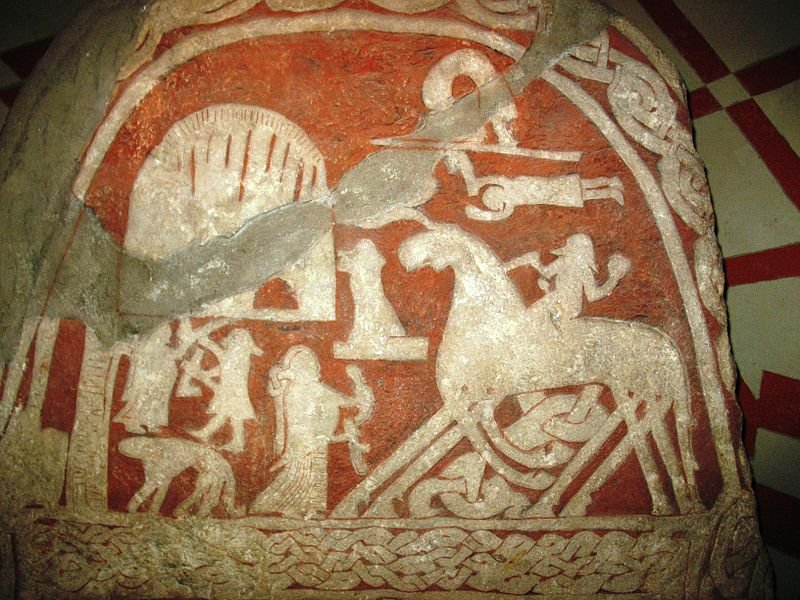 A female figure bears a horn to a rider on an eight-legged horse on the Tjängvide image stone in Sweden. Credit: Berig - CC BY-SA 4.0
A female figure bears a horn to a rider on an eight-legged horse on the Tjängvide image stone in Sweden. Credit: Berig - CC BY-SA 4.0
Valkyries are very similar to those that escort the dead to Hades or other forms of the afterlife in various mythologies throughout human history, particularly in Greek legends. It is interesting to note that common themes and figures occur throughout human history and across multiple cultures or societies.
Updated on August 27, 2024
Written by A. Sutherland - AncientPages.com Staff Writer
Copyright © AncientPages.com All rights reserved. This material may not be published, broadcast, rewritten or redistributed in whole or part without the express written permission of AncientPages.com
Expand for referencesMore From Ancient Pages
-
 Baffling Copper Scroll – A Treasure Map Leading To A Secret Lost Temple?
Featured Stories | Mar 17, 2018
Baffling Copper Scroll – A Treasure Map Leading To A Secret Lost Temple?
Featured Stories | Mar 17, 2018 -
 Radiocarbon Dating Sheds Light On Historical Events In The Ancient City Of Gezer
Archaeology | Nov 15, 2023
Radiocarbon Dating Sheds Light On Historical Events In The Ancient City Of Gezer
Archaeology | Nov 15, 2023 -
 Mysterious Mummified Woman With A Christian Cross On Her Chest Dashes Hopes Of Finding First Russian Fortress In Yakutia
Archaeology | Dec 12, 2019
Mysterious Mummified Woman With A Christian Cross On Her Chest Dashes Hopes Of Finding First Russian Fortress In Yakutia
Archaeology | Dec 12, 2019 -
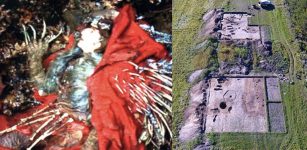 The Birdman Of Siberia: Sensational Finds In The Heart Of Russia Puzzle Scientists
Archaeology | May 31, 2019
The Birdman Of Siberia: Sensational Finds In The Heart Of Russia Puzzle Scientists
Archaeology | May 31, 2019 -
 The Perplexing Story Of The Seven Continents And The Seven Mysterious Races – Distant Past – Part 1
Featured Stories | May 9, 2022
The Perplexing Story Of The Seven Continents And The Seven Mysterious Races – Distant Past – Part 1
Featured Stories | May 9, 2022 -
 Bizarre Event – Why Did Hundreds Of Individuals Suddenly Freak Out At A Cemetery?
Featured Stories | May 30, 2023
Bizarre Event – Why Did Hundreds Of Individuals Suddenly Freak Out At A Cemetery?
Featured Stories | May 30, 2023 -
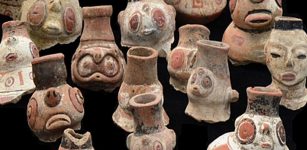 Ancient DNA Tells Story Of Caribbean’s Early Humans
Archaeology | Dec 28, 2020
Ancient DNA Tells Story Of Caribbean’s Early Humans
Archaeology | Dec 28, 2020 -
 Biblical Mystery Of Urim And Thummim: God’s Puzzling Communication Devices
Biblical Mysteries | Jun 18, 2017
Biblical Mystery Of Urim And Thummim: God’s Puzzling Communication Devices
Biblical Mysteries | Jun 18, 2017 -
 Mabon Festival And The Autumn Equinox Celebrated By Pagans
Ancient Traditions And Customs | Sep 19, 2024
Mabon Festival And The Autumn Equinox Celebrated By Pagans
Ancient Traditions And Customs | Sep 19, 2024 -
 Strange Ancient And Medieval Encounters With Unusual Beings Reported And Documented
Featured Stories | Jan 15, 2024
Strange Ancient And Medieval Encounters With Unusual Beings Reported And Documented
Featured Stories | Jan 15, 2024 -
 Being Left-Handed Was A Sign Of Evil Until Only Recently
Ancient History Facts | Jun 29, 2018
Being Left-Handed Was A Sign Of Evil Until Only Recently
Ancient History Facts | Jun 29, 2018 -
 Mahabalipuram: Ancient Ruined City And Its Marvellous Rock-Cut Architecture In South India
Featured Stories | Jul 25, 2021
Mahabalipuram: Ancient Ruined City And Its Marvellous Rock-Cut Architecture In South India
Featured Stories | Jul 25, 2021 -
 Legendary Grianán Of Aileach Built By God Dagda Of Tuatha De Danann Was Once The Royal Seat Of The Kingdom Of Ailech
Featured Stories | May 13, 2021
Legendary Grianán Of Aileach Built By God Dagda Of Tuatha De Danann Was Once The Royal Seat Of The Kingdom Of Ailech
Featured Stories | May 13, 2021 -
 Yet Another Beautiful Roman Mosaic In Hatay, Turkey
Archaeology | Jul 14, 2022
Yet Another Beautiful Roman Mosaic In Hatay, Turkey
Archaeology | Jul 14, 2022 -
 Two-Million-Year-Old DNA Opens A ‘Game-Changing’ New Chapter In The History Of Evolution
Archaeology | Dec 7, 2022
Two-Million-Year-Old DNA Opens A ‘Game-Changing’ New Chapter In The History Of Evolution
Archaeology | Dec 7, 2022 -
 How Ramesses II Became The Greatest Pharaoh In Egypt
Featured Stories | Jun 6, 2021
How Ramesses II Became The Greatest Pharaoh In Egypt
Featured Stories | Jun 6, 2021 -
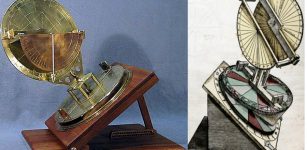 Torquetum: Sophisticated Medieval Astronomical Instrument
Ancient History Facts | Jul 12, 2018
Torquetum: Sophisticated Medieval Astronomical Instrument
Ancient History Facts | Jul 12, 2018 -
 Ancient Biblical Manuscript M.910 We Are Afraid To Open May Contain A Surprise
Archaeology | Feb 19, 2018
Ancient Biblical Manuscript M.910 We Are Afraid To Open May Contain A Surprise
Archaeology | Feb 19, 2018 -
 DNA Breakthrough – New Human Gene Cluster Sequence Discovered
Evolution | Nov 24, 2023
DNA Breakthrough – New Human Gene Cluster Sequence Discovered
Evolution | Nov 24, 2023 -
 170-Million-Year-Old Sea Monster Identified As The Oldest Mega-Predatory Pliosaur
Evolution | Oct 23, 2023
170-Million-Year-Old Sea Monster Identified As The Oldest Mega-Predatory Pliosaur
Evolution | Oct 23, 2023

